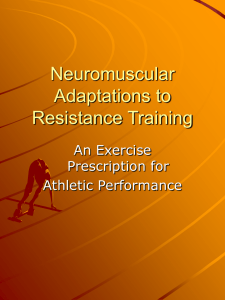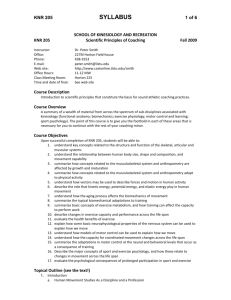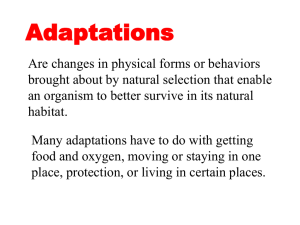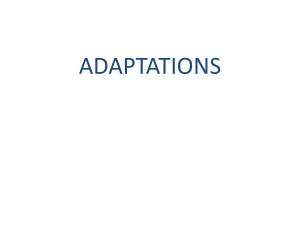Chronic Neurological Adaptations to High Intensity Resistance
advertisement
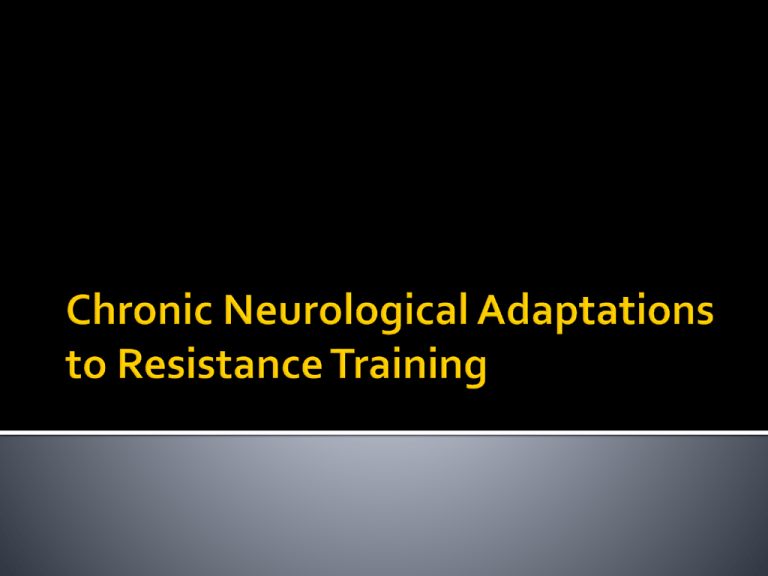
What is Chronic? What is Trained? Hypertrophy is not the only factor Sometimes hypertrophy isn’t warranted SAID principle Strength:Bodyweight Sports Strength Athletics Track and Field Combat Sports Field Sports Swimming Life Short Term Adapations to Training: Increase Motor Unit Recruitment Pattern Acquisition Changes in H-reflex activity Decrease in Inhibitory Resistance (GTO, Antagonist Activity) Increase Synergist Assistance Increase High Threshold MU Recruitment Increase Motor Unit Syncronization (minimal effect) Do these adaptations just stop? A plateau is observed in research and in the field. However, training is consistently varied from stimulus, volume, load, etc. So improvements can be continued. Acute Adaptations Continue to a greater degree. Motor Units High Threshold Firing Frequency Conduction Velocity Spinal Cord Plasticity Interneuron Circuitry Supraspinal Activity Trained maximize activation Simple vs. Complex Movements Proposed that complex movements have a much larger window for adaptation Motor Unit coordination now a much bigger factor Strength is Relative to the Task 80% MVC Isomentric Contraction of Elbow Flexor vs. Lifting a 400 lb stone Training age: Experience = need for specificity Experience = less dramatic response With proper periodization of training performance can continue to improve. Research is needed in the area There is evidence that neurological changes continue to occur throughout the training age of a strength athlete when training necessitates a large neural contribution (high load/speed training) Understanding these changes will allow for a better understanding of training application and progression What is/are neurological adaptations to resistance training that would allow for increased strength? A. Increased Inhibitory activity of spinal interneurons B. Increased supraspinal activation C. Increased High Threshold Motor Unit activation D. Both B and C Komi, P. V. (2003). Strength and power in sports. (2 ed.). Oxford, UK: Blackwell Sciences Ltd. Cormie, P., McGuigan, M. R., & Newton, R. U. (2011). Developing maximal neuromuscular power: Part i biological basis of maximal power production. Journal of Sports Medicine, 41(1), 17-38. Fernandez del Olmo, M., Reimunde, P., Viana, O., Martin Acero, R., & Cudiero, J. (2006). Chronic neural adaptations induced by long-term resistance training in humans. European Journal of Applied Physiology, 96, 722-728. Carroll, T. J., Riek, S., & Carson, R. G. (2002). The sites of neural adaptation induced by resistance training in humans. Journal of Physiology, 544(2), 641-652. Jacques, D., Semmler, J. G., & Enoka, R. M. (2006). Training adaptations in the behavior of human motor units. Journal of Applied Physiology, 101, 1766-1775. Falvo, M. J., Sirevaag, E. J., Rohrbaugh, J. W., & Earhart, G. M. (2010). European journal of applied physiology. Resistance training induces supraspinal adaptations: Evidence from movement-related cortical potentials, 109, 923-933. Fry, A. C., Schilling, B. K., Staron, R. S., Hagerman, F. C., Hikida, R. S., & Thrush, J. T. (2003). Muscle fiber characteristics and performance correlates of male olympic style weightlifters. Journal of Strength and Conditioning Research, 17(4), 746-754.




